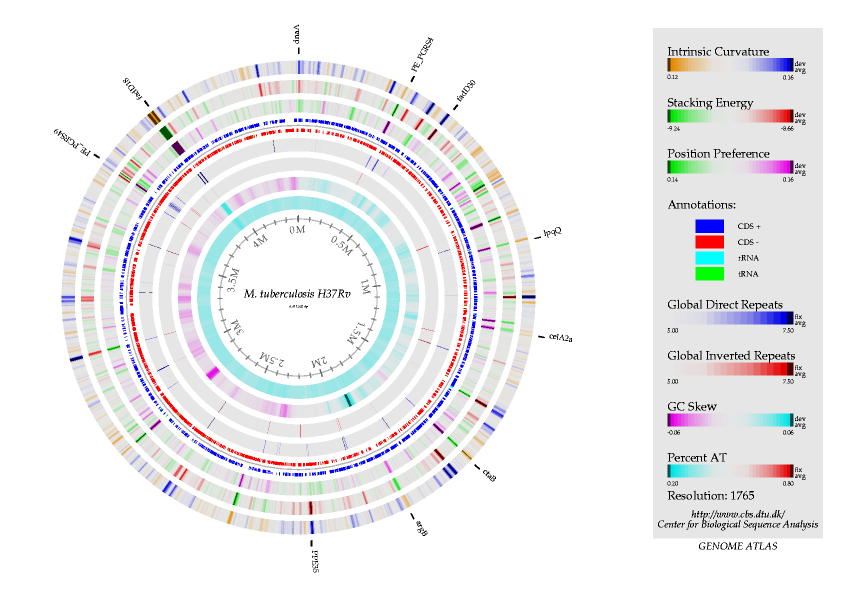Mycobacterium*
Classification
__________________________________________________________________________________________________________________________________________________________________________________________
Higher Order Taxa
Bacteria; Actinobacteria; Actinobacteria (class); Actinobacteridae; Actinomycetales; Corynebacterineae; Mycobacteriaceae; Mycobacterium; Mycobacterium tuberculosis complex
Species
Mycobacterium tuberculosis, M. leprae
Description And Significance
___________________________________________________________________________________________________________________________________________________________________________________________
The earliest appearance of tuberculosis in recorded human history is in China around 2700BC. Egyptian mummies have also been studied and have been found to contain traces of tuberculosis in their spinal cords. Before the explosion of modern scientific naming, tuberculosis was referred to as consumption, and though the cause was unknown, people of the time found that it spread through close living quarters, and at one point during the seventeenth century it's transmission method was found to be sputum, or phlegm from the upper respiratory system. It wasn't until the eighteenth century that scientists recognized the virus as transmittable between two hosts. It was first isolated by Robert Koch using a staining technique that allowed him to see the microbe. This microbe continues to be devastating throughout the world today, killing roughly three million people a year as estimated by the WHO (World Health Organization.) It is currently transmitted most frequently though third world, low income countries, specifically parts of Africa, Asia minor, and Latin America.
Genomic Structure
The complex structure of mycobacterium contains 4,411,522 base pairs with 3,924 predicted protein-coding sequences, and a relatively high G+C content of 65.6%. It remains to be one of the most advanced and one of the largest bacterial sequences known. It appears as one circular chromosome and the largest known strain contains 4,293 genes and 56 pseudogenes.

________________________________________________________________________________________________________________________________________________________________________
Cell Structure, Metabolism, and Life Cycle
Mycobacteria are rod shaped, gram-positive microbes (caused by it's lack of an outer cell membrane), with the ability to manufacture most of their own needs including production of vitamins and amino acids although they lack the power to metabolize and depend on the host they seek in order to provide the opportunity to process metabolically. In addition to peptidoglycan, Mycobacterium contains a large amount of glycolipids, that make up approximately 60% of the acid-fast cell wall. This causes the organism to grow slowly and to be more resistant to medication as well as other invading immune system defenders. The surface proteins in such a wall help to function as enzymes that power the cell's chemical reactions. The bacterium has neither cilia or flagella, and is therefore non-motile. Its hydrophobic cell wall contains a high concentration of lipids which repels water.Metabolically, M. tuberculosis is obligate aerobic; it requires oxygen to undergo cellular respiration. The Ziehl-Neelsen acid-fast staining procedure is widely used to identify the organism. This method is particularly dangerous because the bacterium must be cultured to perform the gram stain. identification Pathogenic tuberculosis can be identified by observing symptoms in a patient and the common TB skin test. TB bacterium have a life span of roughly twelve to eighteen hours.Its life cycle as a human pathogen begins as it enters the body through the lungs. It is then taken up by the macrophages where it multiplies. The bacterium is then spread throughout the lymphatic system. At this stage, it is either eliminated from the body, or causes the physical disease.
_______________________________________________________________________________________________________________________________________________________________________________________
Ecology And Pathogenesis
Tuberculosis is suspected to have originated from a soil based disease that infected livestock that became transmittable to humans when those animals were domesticated. Because the virus is spread from person to person, it is easy to see why it spreads the best where people are living in very close quarters, in dirty environments that would place many of one person's germs in a single place for transmission to another human being. The bacteria are picked up by macrophages once they enter the lungs and multiply from there. The virus is lysogenic and can develop into a full infection in anywhere from a few weeks to an entire year once it makes its way into the lymphatic system. The symptoms of tuberculosis in humans include: Persistent cough, fatigue, lethargy, weight loss, loss of appetite, fever, chest pains, and the coughing up of blood. The most common way to test whether or not you are infected with TB is the Mantoux test. A small amount of tuberculin is injected into the arm. After 2 to 3 days, the person will come back to the hospital for a final analysis. The tuberculin causes swelling and/or a bump in the arm. The size of the bump determines if a person is infected with TB. A bump that is 10 mm or longer generally means that you are infected.
_______________________________________________________________________________________________________________________________________________________________________________________
Interesting Fact
Modern science is currently undergoing an investigation into one particular strain of mycobacterium tuberculosis that is resistant to not just one drug normally used to treat the disease, but is resistant to all three current treatments, including popular drugs isoniazied and rifampin. Unfortunatley, this drug resistant strain retains the ability to breed new strains of the virus and make the overall disease much more difficult to handle. The treatment for this specific strain is extremely costly, and the disease tends to prove to be fatal. In fact, currently about 7.8% of all clinical tuberculosis cases are of this particular strain, according to statistics gathered by the CDC in 2005. The WHO estimates that over 50 million people may be infected with the drug resistant strain of tuberculosis. There has also found to be some sort of link between the drug resistant strain, codenamed MDR-TB, and the HIV virus. In 2006, 4% of HIV cases in America also presented symptoms of MDR-TB
________________________________________________________________________________________________________________________________________________________________________________ _____________________________________________________________________________________________________________________________________________________________________________________
References
http://emedicinehealth.com/tuberculosis.article_em.htm http://respiratory-lung.health-cares.net/tuberculosis-causes.php http://www.lungusa.org/site/pp.asp?c=dvLUK9O0E&b=35778 http://library.med.utah.edu/WebPath/TUTORIAL?MTB?MTB.html http://textbookofbacteriology.net/tuberculosis.html http://www.dhpe.org/infect/tb.html http://www.biohealthbase.org/GSearch/statsAutomation.do?decorator=Mycobacterium http://www.cbs.dtu.dk/services/GenomeAtlas/show-atlas.php?kingdom=Bacteria&GLgenus=Mycobacterium&segmentid=Mtuberculosis_H37Rv_Main&type=genomeatlas http://www.lungusa.org/site/pp.asp?c=dvLUK9O0E&b=35815 http://student.ccbcmd.edu/courses/bio141/lecguide/unit1/prostruct/afcw.html
Information Compiled By:
Alderman, Liz Arias, Gian Broadway, Michelle Evers, Samantha Horton, Sarah Tomasino, Magen Yegani, Mina
North Carolina State University, MB103, Fall semester 2007
http://www.revolutionhealth.com/conditions/lung/tuberculosis/ "Brief History of Tuberculosis." NJMS National Tuberculosis Center. <http://www.umdnj.edu/~ntbcweb/history.htm>
"Tuberculosis." World Health Organization. <http://www.who.int/mediacentre/factsheets/fs104/en/print.html>
